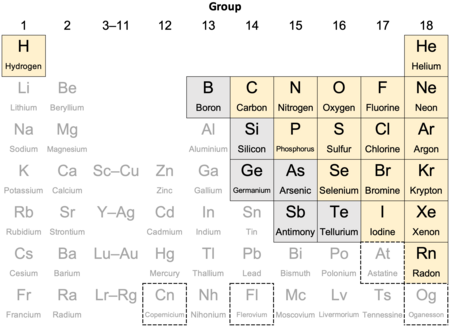
Back Niemetaal Afrikaans No metal AN अधातु ANP لا فلز Arabic لافيليز ARY Non metal AST Qeyri-metallar Azerbaijani Неметалы Byelorussian Немэтал BE-X-OLD Неметал Bulgarian
A request that this article title be changed to Nonmetal (chemistry) is under discussion. Please do not move this article until the discussion is closed. |
This article has multiple issues. Please help improve it or discuss these issues on the talk page. (Learn how and when to remove these template messages)
|
| Nonmetals in their periodic table context |

|
| always/usually considered nonmetals[1][2][3] |
| metalloids, sometimes considered nonmetals[a] |
| status as nonmetal or metal unconfirmed[5] |
| Part of a series on the |
| Periodic table |
|---|
Nonmetals in chemistry or non-metallic elements are chemical elements that have high electronegativity and mostly lack distinctive metallic properties. They range from colorless gases like hydrogen to shiny crystals like iodine. Physically, they are usually lighter (less dense) than metals and are often poor conductors of heat and electricity. Since nonmetals have high electronegativity they usually attract electrons in a chemical bond with another element, and their oxides tend to be acidic.
Seventeen elements are recognized as nonmetals. Additionally, some or all of six borderline elements (metalloids) are sometimes counted as nonmetals.
The two lightest nonmetals, hydrogen and helium, together make up about 98% of the mass of the observable universe. Five nonmetallic elements—hydrogen, carbon, nitrogen, oxygen, and silicon—make up the bulk of Earth's oceans, atmosphere, biosphere, and are in compounds in the crust.
Industrial uses of nonmetals include in electronics, energy storage, agriculture, and chemical production.
Most nonmetallic elements were identified in the 18th and 19th centuries. While a distinction between metals and other minerals had existed since antiquity, the classification of chemical elements as metallic or nonmetallic emerged only in the late 18th century. Since then over two dozen properties have been suggested as criteria for distinguishing nonmetals from metals.
- ^ Cite error: The named reference
Larrañagawas invoked but never defined (see the help page). - ^ Cite error: The named reference
Steudelwas invoked but never defined (see the help page). - ^ a b Cite error: The named reference
Vernon2013was invoked but never defined (see the help page). - ^ Cite error: The named reference
Goodrich etcwas invoked but never defined (see the help page). - ^ At: Restrepo et al. 2006, p. 411; Thornton & Burdette 2010, p. 86; Hermann, Hoffmann & Ashcroft 2013, pp. 11604‒1‒11604‒5; Cn: Mewes et al. 2019; Fl: Florez et al. 2022; Og: Smits et al. 2020
Cite error: There are <ref group=lower-alpha> tags or {{efn}} templates on this page, but the references will not show without a {{reflist|group=lower-alpha}} template or {{notelist}} template (see the help page).